Whitehot Magazine
October 2025
"The Best Art In The World"
"The Best Art In The World"
October 2025
Frieze Art Fair 2025: Three Dimensions and a Revelation
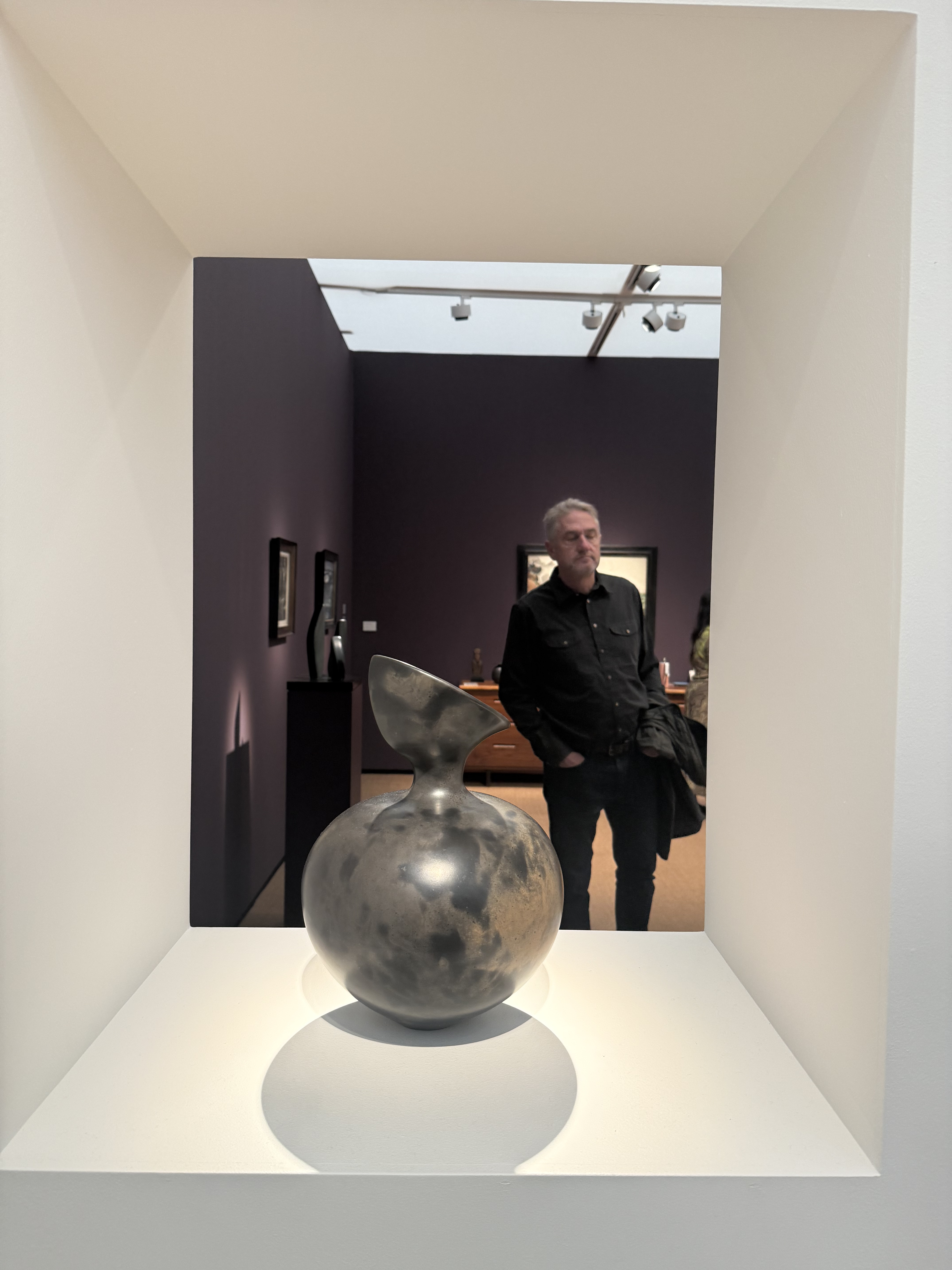
Magdalene A.N. Odundo DBE, Untitled, 1984, photo by Delia Cabral
By Delia Cabral, October 21, 2025
Frieze London and Frieze Masters 2025. I have lost count of how many VIP fair openings I have attended over the years. Once upon a time, it was exciting; I buzzed with a child's Christmas morning anticipation. Lately, though, I've been arriving at art fairs with the dread of an overworked mother. Last week seemed no different as I wound my way past influencers and the known and unknown VIPs. Yet this time, something had shifted. Dare I say it, I sensed optimism.
As soon as I entered, I noticed a material turn in contemporary art practice. Protruding from booth walls, commanding sculptural space, works in glass, ceramics, textiles, resin and Perspex proliferated. Across the fair's 280+ galleries representing over 45 countries, another promising trend emerged: a broader array of artists, notably those with roots in Indigenous craft traditions, recontextualising material practice to expand contemporary art discourse.
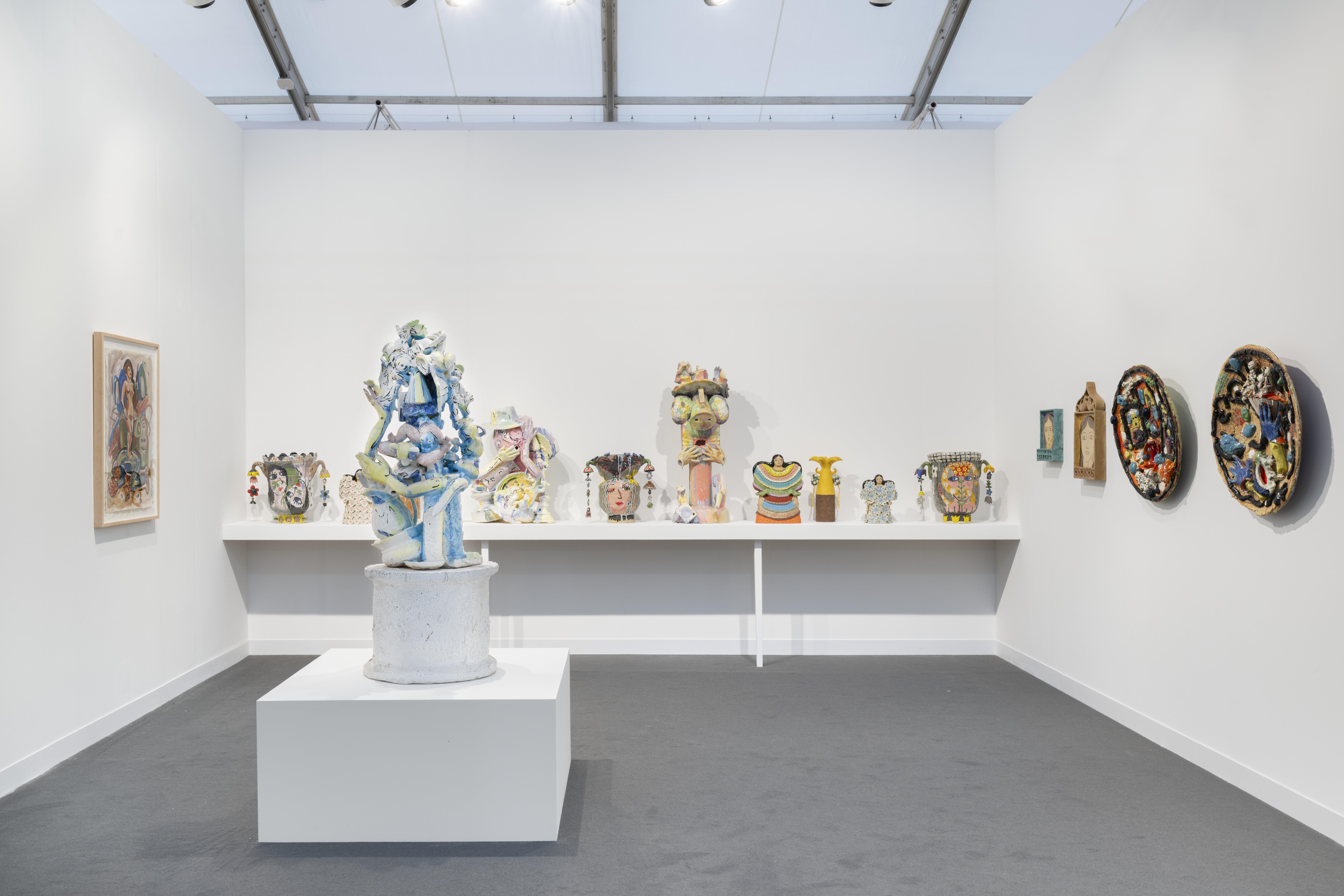
The Pit booth installation, image courtesy of The Pit gallery
Facing the entrance, The Pit, a California-based gallery from Glendale, set the material tone with Three Generations of Female California Ceramics. Viola Frey, a Bay Area pioneer known for feminist sculptural and ceramic works emblematic of California's Funk art movement, anchored the presentation with a monumental work from the 1980s: Untitled (Bricolage Bust with Fan Nose and Elbow on Pitcher, Untitled Round White Table),c. 1987. Standing over four feet tall and glazed in colours reminiscent of mid-century tchotchkes said to have influenced her aesthetic, the commanding assemblage deconstructs feminine imagery through fractured form and domestic reference. Expanding on the trajectory of this seminal artist, Jennifer King's ornately decorated vessels extended Frey's feminist investigation, encoding women's accumulated experiences in richly layered, vibrant urns brimming with life. Maryam Yousif, the youngest, evokes a new traditional sensibility in her stoneware pieces, glazed with a soft, feminine palette, weaving together historical traditions with contemporary cultural imagery to create objects that depict the evolving feminist story—three generations expressing through clay, not a trend, but a continuum.
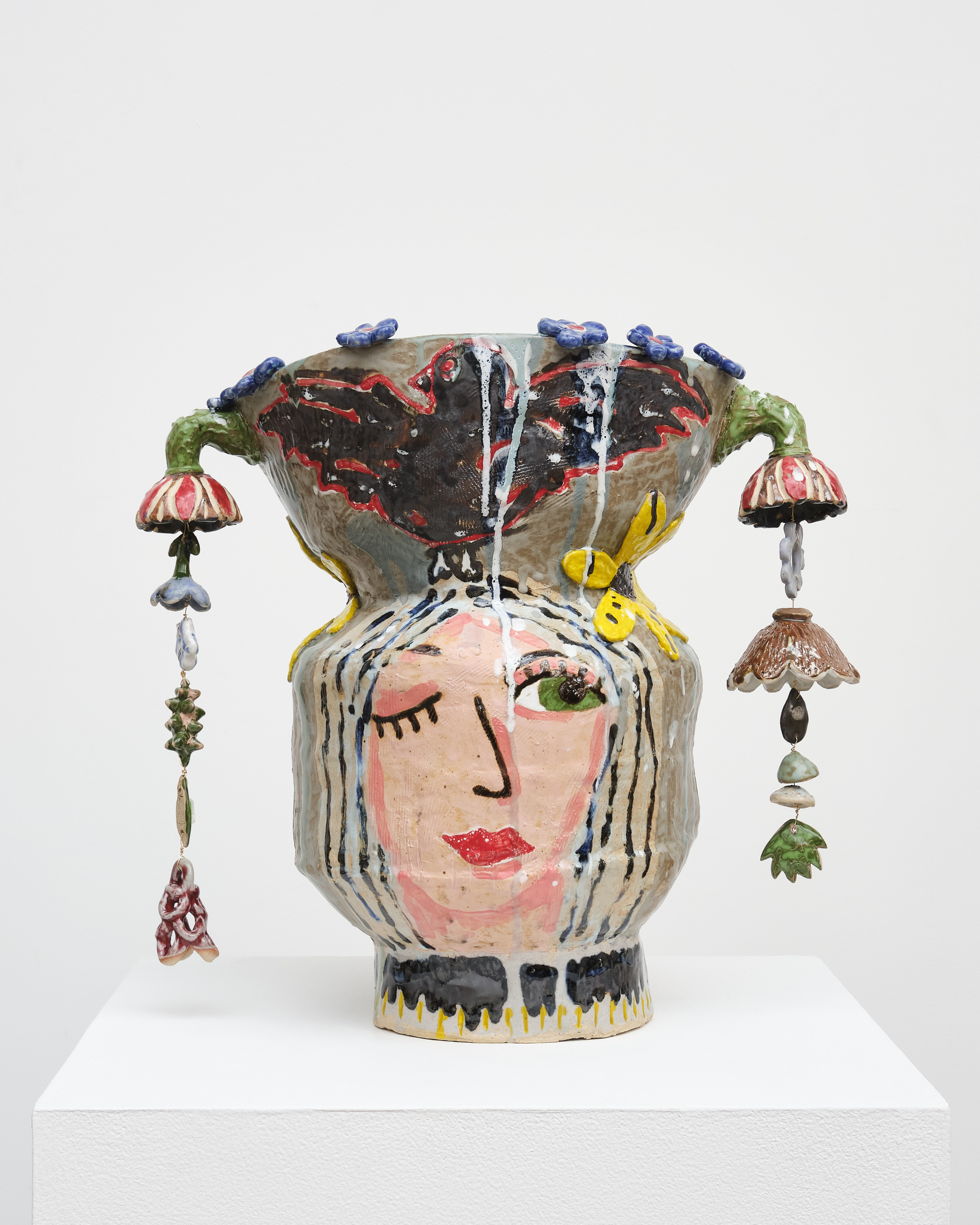 Jennifer King raven song, raven flight (helianthus), 2025 Stoneware, glaze, wire, moonstones, quartz crystal 20 x 17 x 12 in 50.80 x 43.18 x 30.48 cm, image courtesy of The Pit gallery
Jennifer King raven song, raven flight (helianthus), 2025 Stoneware, glaze, wire, moonstones, quartz crystal 20 x 17 x 12 in 50.80 x 43.18 x 30.48 cm, image courtesy of The Pit gallery
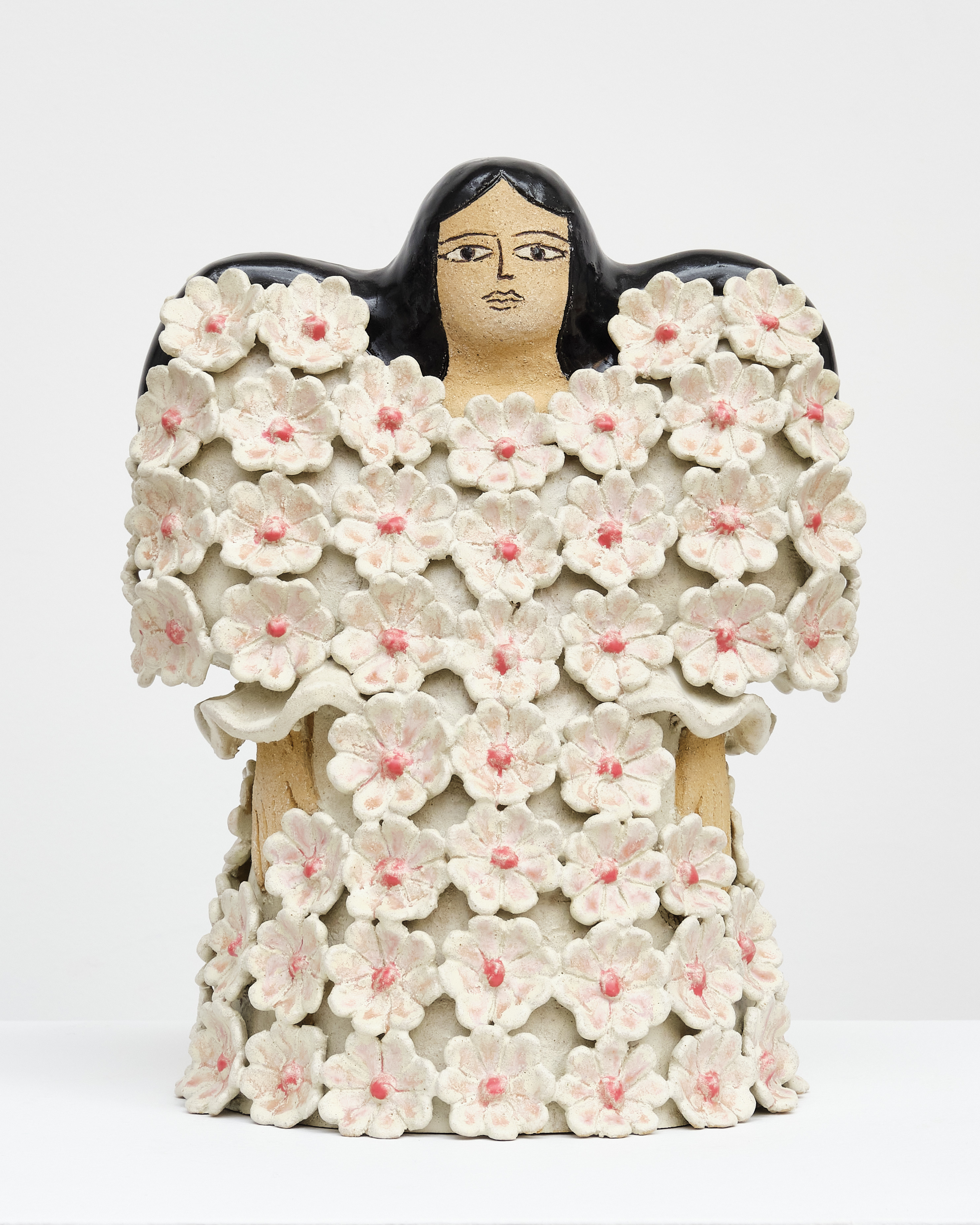 Maryam Yousif Habibti in Rosette Dress (Pink Dream), 2025, Glazed stoneware 14 x 10.5 x 8.5 in 35.56 x 26.67 x 21.59 cm. Image courtesy of The Pit gallery
Maryam Yousif Habibti in Rosette Dress (Pink Dream), 2025, Glazed stoneware 14 x 10.5 x 8.5 in 35.56 x 26.67 x 21.59 cm. Image courtesy of The Pit gallery
Noémie Goudal exemplifies this material expansiveness. The French artist, based in London, is known primarily for her photography and film work, yet her Terrella installation in the Deutsche Bank Lounge comprised 15 clay and porcelain sculptures. Created during her residency at Manufacture de Sèvres in collaboration with science historian Gabriel Gohau, each sculpture visualises a different cosmological hypothesis about Earth's formation, from antiquity to the present day. The work demonstrates how scientific depictions of our world have evolved across centuries, rendered tangible through ceramic form.
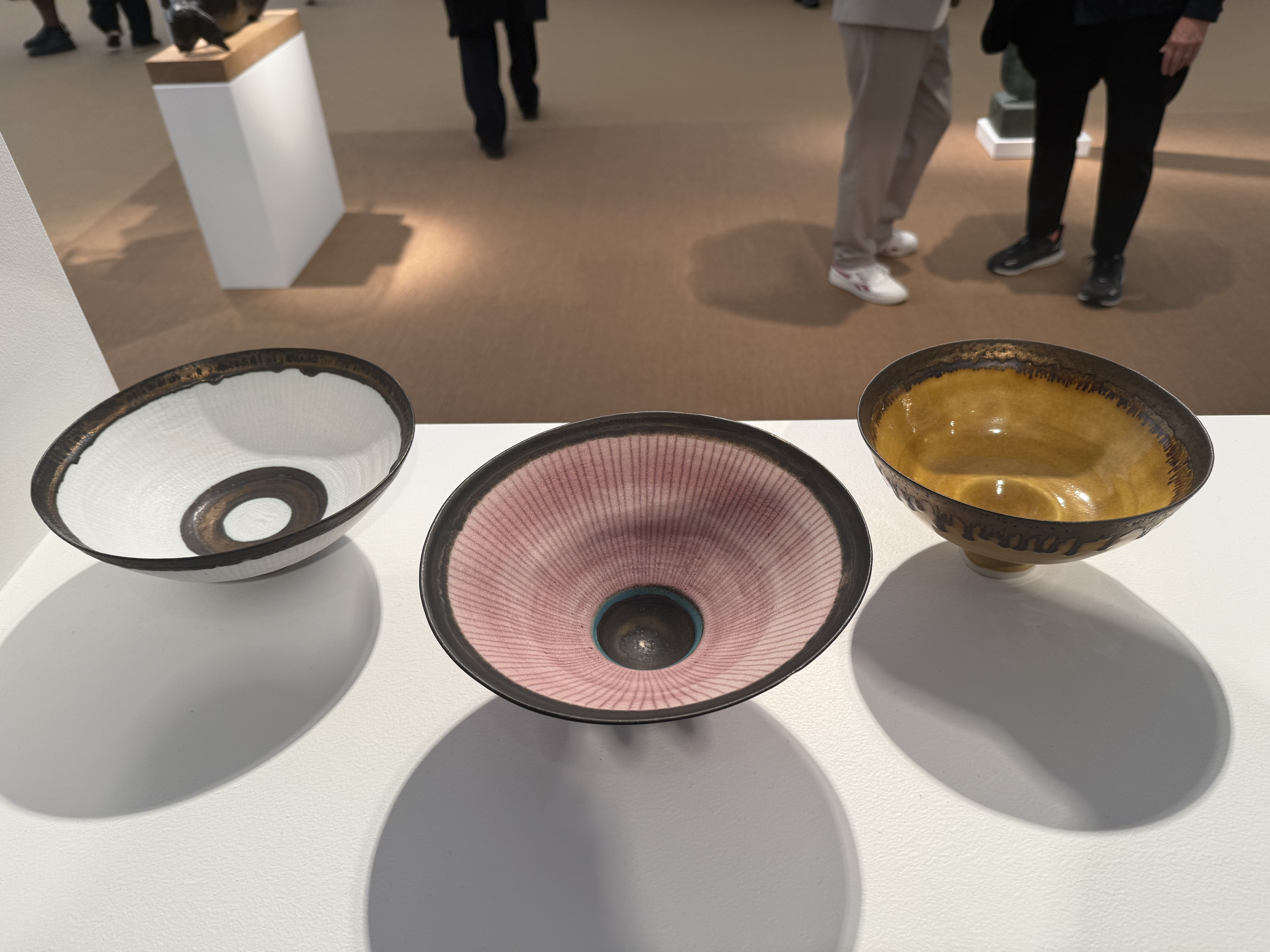 Lucie Rei, various porcelain bowls from the early 80s. Image by Delia Cabral
Lucie Rei, various porcelain bowls from the early 80s. Image by Delia Cabral
Ceramic works were a consistent material across many booths, a pattern that carried over to Frieze Masters. Offer Waterman’s London gallery, anchoring the conversation with Dame Lucie Rie's iconic, porcelain gravity-defying bowls, known for their whisper-thinness, presented alongside Dame Magdalene Anyango Namakhiya Odundo DBE's burnished terracotta vessels, whose surfaces are shaped through smoke and fire into shiny, timeless forms. In other booths, the ceramic lineage extended from Edmund de Waal's restrained celadon cylinders to Sir Grayson Perry's raucous, subversive pots: proof that the medium now commands space from quiet meditation to loud provocation.
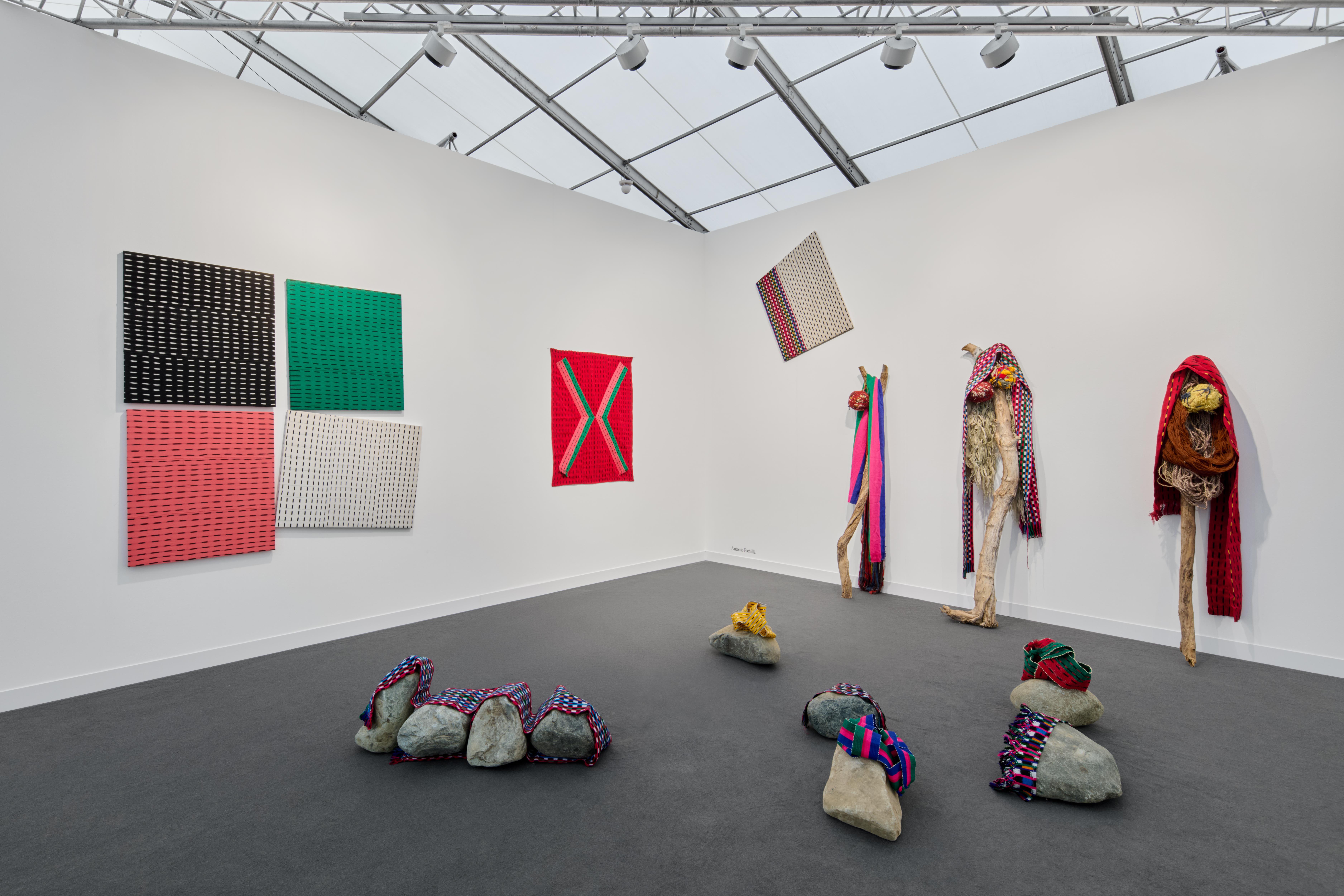
2025 Earth Knots, a solo project featuring a selection of works by Guatemalan artist Antonio Pichillá. Image courtesy of Portas Vilaseca
Textiles, fibre arts and natural materials also featured prominently, recontextualised by artists who brought their cultural heritage into contemporary discourse. Portas Vilaseca, a Rio de Janeiro gallery, greeted fairgoers with Guatemalan artist Antonio Pichillá's solo project Earth Knots, a body of work expressing his desire to protect nature through the ancestral textiles of his Tz'utujil Mayan heritage, a craft learned from his mother and grandmother. The booth featured textile works, paintings, video and installation. His textiles, dyed with native plants from his homeland, employ bright colours as protective warnings against contemporary consumer culture's destructive impulses. His installations wrap protective woven textiles around natural elements —rocks and branches —shielding them. His compositions have a modern, contemporary feel, minimal, clean arrangements, and are dazzling to behold. Pichillá is an artist to watch; his work is very sought after and is in prominent collections such as the Museo Reina Sofia, Spain; Tate Museum, London; Detroit Contemporary Art Museum, and others.
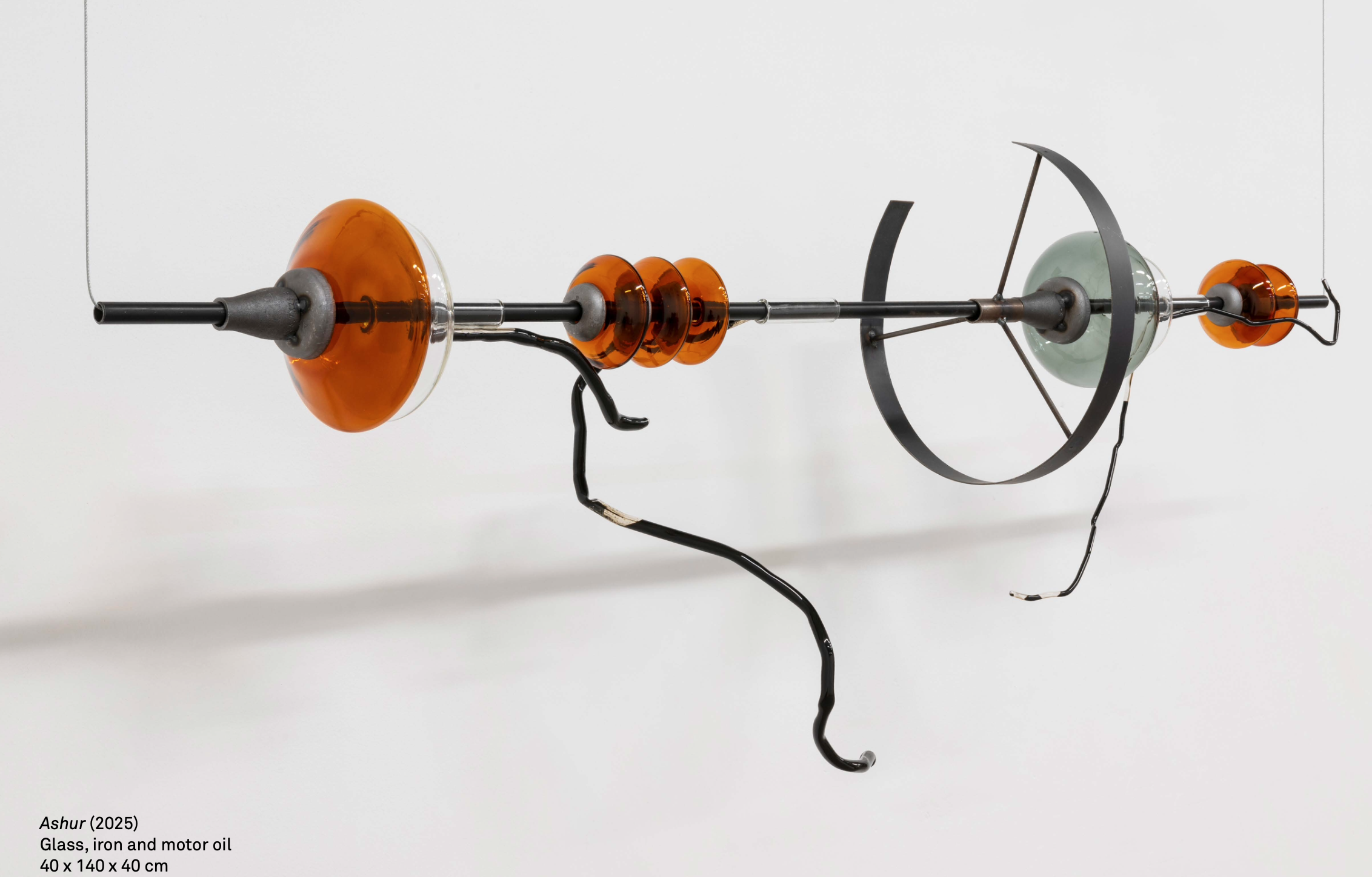 Lara Fluxà, Image courtesy Bombon Projects.
Lara Fluxà, Image courtesy Bombon Projects.
Beyond ceramics and textiles, glass emerged as another medium for material investigation. Spanish artist Lara Fluxà, represented by Barcelona's Bombon Projects, constructed a melancholic installation that appeared at once surreal and scientific. Blown glass vessels, some containing alcohol, water or tar, hung suspended from metal structures anchored to the walls, hovering above viewers like components from a dismantled power plant. The work's precarious balance mirrors its conceptual inquiry: progress versus preservation, resource extraction versus environmental protection.
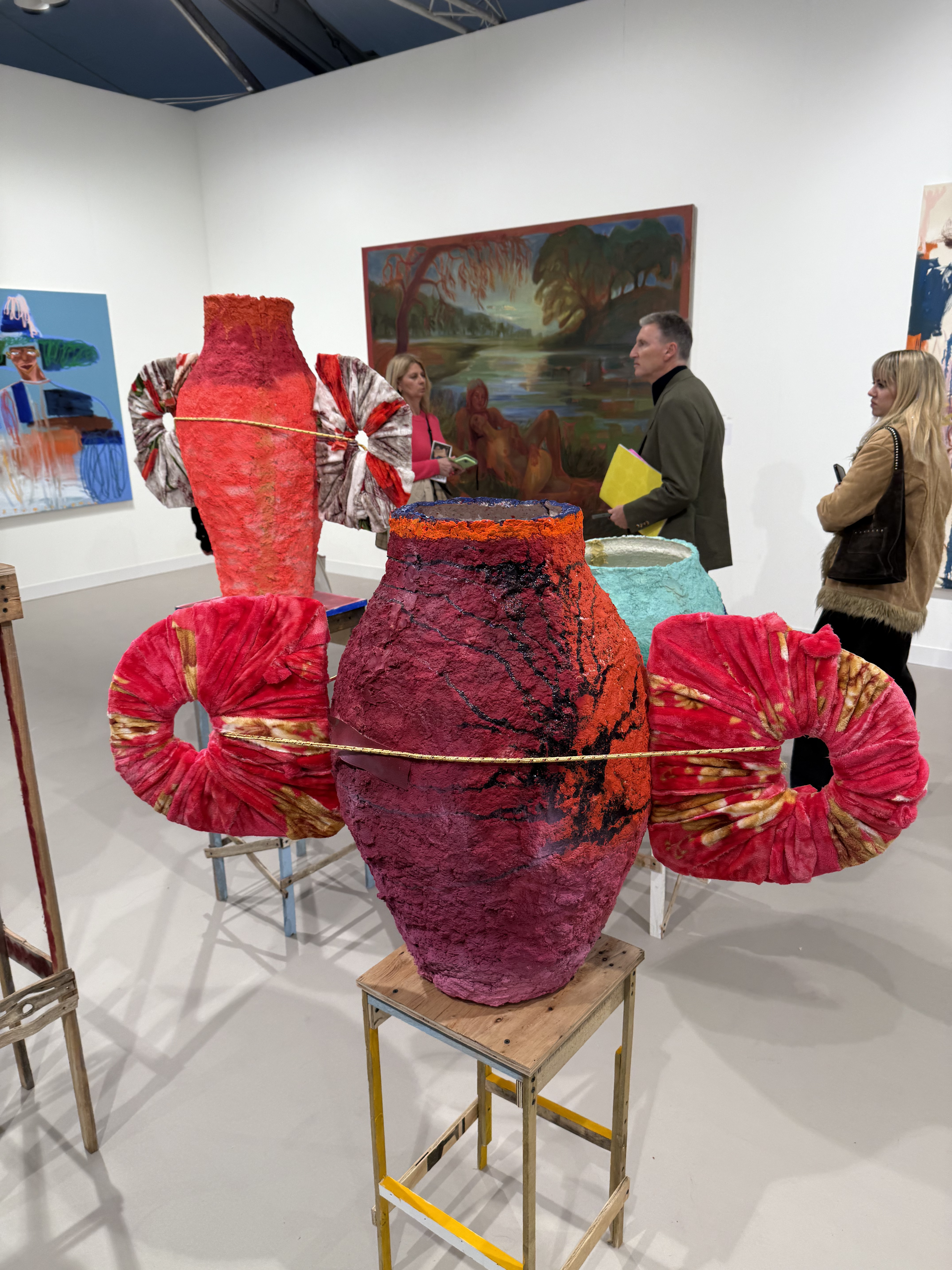 Studio Lenca, Monuments series (2024). Image by Delia Cabral
Studio Lenca, Monuments series (2024). Image by Delia Cabral
This material turn, coupled with the recontextualisation of Indigenous craft traditions, threaded throughout Frieze, at Carl Freedman Gallery, a Margate-based space, Studio Lenca, the practice of Salvadoran artist José Campos, is a compelling example. His brightly coloured portrait paintings draw from his tropical homeland, celebrating the cultural richness that diversity brings to host communities when welcomed and protected. But it was his Monuments series (2024) that commanded attention: large vessel forms made from paper, blankets and found objects rather than clay. These sculptures evoke traditional functional pottery, yet cannot hold water; instead, they hold memory. Constructed from accumulated objects picked up and held onto, they speak to displacement and the search for homecoming, craft traditions rendered in the materials of migration itself.
Speaking to galleries during the fair amplified this optimistic shift back to materiality and cross-cultural exploration, away from the heated, hyped markets that have burnt fairgoers out. Programmes like Artist-to-Artist, which fairs like Frieze have been facilitating, are empowering vehicles; this year, Frieze brought Echoes in the Present, curated by Dr Jareh Das, which proved particularly significant in this regard, exploring connections between artists from Brazil, Africa and their diasporas through shared histories of forced migration and ongoing cultural exchange—a hot topic in today’s global political landscape. The section examined how artists deploy materials to articulate heritage, innovation and speculative futures. This curatorial framework directly supported the material expansiveness visible throughout the fair: when artists root contemporary practice in ancestral knowledge systems, material itself becomes discourse.
As a curator and critical writer with over two decades in the field, and having recently completed an MA in Ceramics and Glass, I initially questioned whether my observations reflected personal bias. Instead, what I witnessed at Frieze suggests a genuine widening of creative discourse, one that the market is finally catching up to. The proliferation of non-traditional materials, the centring of Indigenous craft lineages, the deliberate platform given to artists working outside Western painterly traditions: these aren't trends but correctives, long overdue.
Frieze Masters reinforces what history teaches: these material and cultural conversations are not new; they are merely newly visible to the market. Long remembered as the fair for blue-chip masterworks and record-breaking sales, Frieze Masters has shifted in response to global market forces and evolving creative climate. The change is evident not just in what sells, but in how galleries curate their presentations. Speaking with Mickal Adler, antiquities specialist at Colnaghi Gallery (London, New York, Madrid), the deliberate eclecticism became clear: "This year we focused on bringing artworks with great variety—from ancient art and important Old Master works on paper to, for the first time, 19th-century African sculpture—and placing them in dialogue with 19th- and 20th-century paintings and drawings from Elliott Fine Art. We enjoy bringing an eclectic mix with a focus above all on quality and pieces with deep histories and fascinating stories." This historical depth contextualised what I observed at Frieze London: the ceramics, textiles and hybrid materials commanding attention across contemporary booths have lineages stretching back centuries.
The optimism I felt upon entering Frieze and Frieze Masters signals a substantive shift: galleries moving from purely market-driven presentations towards curatorially focused programming. Rather than chasing the biggest names at the highest prices, booths set a stage for conversation, context and access, expanding from Western-centric narratives to global perspectives, from rigid medium segregation to productive cross-medium dialogue. What emerges is a more generous art market —one that recognises diverse collector appetites and, crucially, diverse artistic lineages.
When major commercial platforms like Frieze centre Indigenous craft lineages and when Deutsche Bank spotlights ceramic sculpture in their lounge, as well as when galleries lead with textiles rather than relegating them to secondary booths, these are not merely aesthetic choices, but a powerful acknowledgement that a long overdue widening of the established contemporary art scene is now a fact. The question isn't whether ceramics, textiles and hybrid materials belong in contemporary art discourse. It's why we pretended for so long that they didn't.
That Christmas morning feeling isn't entirely lost after all; it has returned, meandering past ceramics by three generations of California women, past Guatemalan textiles protecting nature through ancestral practice, past vessels holding memory rather than water. I recognised something I had been missing: genuine discovery. I hope this material focus expands beyond Frieze and Frieze Masters to the other art fairs and art galleries at large. My wish is that fairgoers and collectors’ hopeful anticipation is met with a varied and expanded artistic discourse that includes voices, materials, and traditions long present but persistently marginalised until now.

Delia Cabral
Delia Cabral is a curator and an international art dealer, as well as an art critic and writer. As an innovative leader in the art world for 20 years, Cabral cultivated her access to an international network of arts professionals and institutions. Having built a reputation in Los Angeles, CA as a gallery owner (Founder, DCA Fine Art), Cabral consistently gained attention for mounting dynamic and critically acclaimed exhibitions. Now based in London Cabral’s experience as an international entrepreneur informs a unique skill set which enables her to access art from global cutting edge to privately held sought after historical works. As a passionate writer and member of the British National Union of Journalists, Cabral is always looking for what’s next in art.
deliacabraluk@gmail.com
https://www.instagram.com/deliacabral/
view all articles from this author








